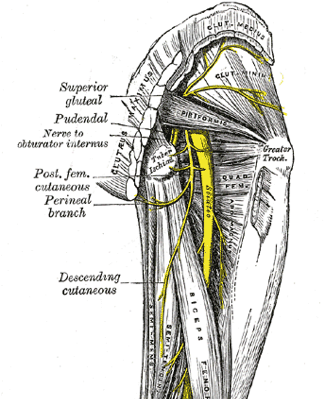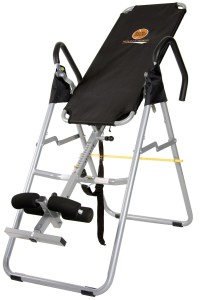Next to stress and back pain, sciatic issues are one of the more common complaints we see in the clinic. In this post, we’ll learn a little anatomy and physiology so we can better understand why the sciatic nerve can get irritated, and what we can do to calm it down.
The sciatic nerve is huge, one of the biggest in humans and many other species. It runs the entire length of the leg, and is composed of nerve roots from L4 (the 4th lumbar vertebrae) to S3 (3rd sacral). It is carries sensory and motor information for just about the entire leg, so anything out of whack with the sciatic nerve can lead to a great deal of discomfort. So what causes sciatica, and how can acupuncture help?
What Causes Sciatica?
Anything putting pressure on the sciatic nerve can elicit a whole host of aggravating symptoms, from a shooting pain down parts of the back or leg, to numbness and tingling over the whole area. Pressure on the nerve can come from a whole host of things: a slipped or bulging disc, spinal stenosis, a tumor or just run of the mill muscle spasms.
Muscle spasms are the most common and usually the easiest to treat, both at home and with acupuncture. When an irritated muscle is the culprit, it is usually a muscle smack dab in the middle of the butt called the piriformis. In the thumbnail at the beginning of the post, it is the little triangular looking one right in the middle, and as you can see it runs right over top of the sciatic nerve. In addition to the piriformis, there are many other muscles along the sciatic nerve, all of which can cause the same symptoms. Thankfully, there are stretches you can do at home that can help, and we’ll talk all about them when we get to the “so what the heck do I do about it” section.
Disc problems, a very common cause of low back pain, can lead to a variety of symptoms including sciatica. The vertebral discs are like little gel-filled cartilage cushions between the bones of the spine (vertebrae) that allow the spine to be both flexible and durable. When a disc is damaged it can bulge (called a protrusion or herniation, depending on the severity) out of place and put pressure on a nerve root, causing pain, numbness and/or tingling along the area supplied by that nerve. Most herniations will heal in a few weeks given proper rest, though severe cases may require surgery. Spinal stenosis fits into this category as well, and is just a fancy way of saying that the holes in the spine that the nerves go through (called foramen) have narrowed. Bulging discs can cause this condition, as well as bone spurs and a few other conditions.
Home Exercises for Sciatica
When a sore muscle is the root of the problem, stretching can be a simple and effective way of getting relief. The stretches in the video linked here will stretch the piriformis as well as just about any other muscle in the area that could be causing sciatic pain. Even in cases where a herniated disc is known to be the cause, these exercises can provide a good deal of pain relief, since disc herniation generally leads to sore muscles all over the low back. When doing any stretch, do it slow and gradual, no bouncing or “ballistic” stretching, or you risk aggravating the problem.
Inversion Tables
Inversion tables are another type of at-home care that can be helpful in alleviating back and sciatic pain, especially when bulging discs are the culprit. The idea behind inversion tables is that they hang you upside-down by your feet, which with the help of gravity takes pressure off the spine allowing it to relax and stretch out a little bit. You know how when your back is hurting, laying down flat and giving a good deep sigh can help it relax and feel better? A big part of that relief is due to your spine no longer carrying the weight of your entire body. Well, an inversion table does the same thing, AND helps elongate the spine a bit.
Now, inversion tables aren’t for everyone. If someone has high blood pressure, a history of stroke, or has glaucoma then an inversion table should absolutely not be used without consulting your doctor first. There are all sorts of models available, though it is important (especially for seniors) that it has some way of controlling the angle. Not everyone needs or wants to hang completely upside-down, and in some cases doing so can actually aggravate back pain. It’s best to start out with a more gentle angle, and work your way up, or back, or whatever. Amazon has a pretty good selection of inversion tables available, which you can see here: Inversion Tables at Amazon
Acupuncture for Sciatica
I know this may come as a surprise to some, but we absolutely recommend you get acupuncture if you have problems with sciatica! Acupuncture can help relieve pain, relax upset muscles, and help your body to heal itself without drugs or expensive and potentially risky surgery. In some cases we may recommend an MRI just to rule out anything serious (badly herniated disc, tumors, etc), but for many patients acupuncture is all they need.
In our Fort Myers acupuncture clinic, we mostly use points on the limbs from the elbows and knees down to treat sciatica, usually a few on each hand and around each ankle (cluster needles around SI3 and GB34, and UB59, 60 and 62, for those interested in specific points). If you’re getting acupuncture elsewhere, understand that there are many different styles of acupuncture, and your acupuncturist may do things a little differently, which is perfectly OK! By the way, if you’re looking for affordable community acupuncture in another town, scroll back up and click on the blue recliner on the right side of the page. That’ll take you to POCA’s locate a clinic page, where you can find affordable community acupuncture clinics like ours all over the place!
An Ounce of Prevention…
The absolute best thing you can do to prevent any spine-related problem is to maintain good posture. Poor posture puts uneven stress on the vertebral discs, making them weaker on one side and more likely to start bulging one day. Having a wallet in your back pocket fits into the “poor posture” category too, because constantly having your hips tilted to one side does the same thing. We know you’ve probably heard it a thousand times, but when lifting anything, make sure you lift with your legs and not your back, and avoid turning at the waist while carrying anything heavy. Lastly, having a strong core (abdominal and back muscles) helps keep the spine stable and less susceptible to injury. Thanks for reading!


